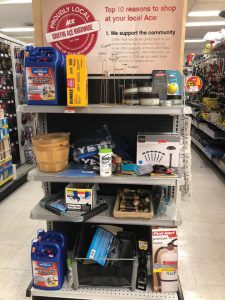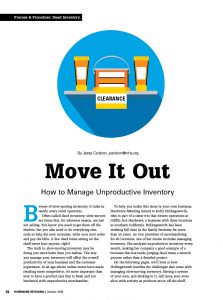Click the image above to download a PDF of the story.
Beware of slow-moving inventory. It lurks in nearly every retail operation.
Often called dead inventory, slow-movers are items that, for whatever reason, are just not selling. You know you need to get them off the shelves, but you also need to do everything else, such as help the next customer, write your next order and pay the bills. A few dead items sitting on the shelf never hurt anyone, right?
The truth is, slow-moving inventory may be doing you more harm than you realize. The way you manage your inventory will affect the overall productivity of your business and the customer experience. In an age where online stores have made retailing more competitive, it’s more important than ever to have a product mix that is fresh and not burdened with unproductive merchandise.
To help you tackle this issue in your own business, Hardware Retailing turned to Kelly Hollingsworth, who is part of a sister trio that directs operations at Griffin Ace Hardware, a business with three locations in southern California. Hollingsworth has been working full time in the family business for more than 25 years. As vice president of merchandising for all locations, one of her duties includes managing inventory. She analyzes unproductive inventory every month, making her company a good example of a business that has made purging dead items a smooth process rather than a dreaded project.
On the following pages, we’ll look at how Hollingsworth handles the challenges that come with managing slow-moving inventory. Having a system of your own, and sticking to it, will keep your store alive with activity as products move off the shelf, rather than being a graveyard that keeps collecting dead products.
In addition to reading this article, make sure those in a leadership position in your business have an understanding of the importance of the entire inventory management process. The North American Retail Hardware Association (NRHA) recently developed a brand new course in Basic Inventory Management. This online course offers foundational information about inventory management and some best practices to follow. Having this foundational understanding will be useful when tackling slow-moving inventory.

Don’t Be Complacent
Often the first barrier to purging unproductive inventory is finding the time to do it. It’s possible that while you know clearing slow-movers is important, but you may not think it’s urgent. With everything else there is to do around the store, it’s easy enough to put off hunting down those items that haven’t sold in a while.
Hollingsworth understands. “It’s not like the store isn’t going to function because you haven’t worked your dead inventory,” she
says. “But your inventory is your biggest asset. There’s a lot of money attached to it, so it needs to be managed appropriately.”
Poorly managed inventory will cause several problems for a business. Every item needs to earn its place. Low product turnover will impact your profitability. According to NRHA’s 2018 Cost of Doing Business Study (CODB), high-profit hardware stores have an inventory turnover of 2.7, a gross margin return on inventory of 194.3 percent and inventory per square foot of $52. If your numbers lag behind those, one of the reasons might be that too many slow-moving products are dragging down your profits.
The customer experience will also suffer if dead items stay on the salesfloor too long. “Customers are shopping everywhere. They know the latest and greatest of what’s out there, and they expect to see it in our store,” Hollingsworth says. “But we can’t just add, add, add and never take away. We have to deal with dead inventory because we need to make room for what’s new.”
Competing with online retailers includes offering an exciting shopping experience that engages the customer, which means having new products and a store that is easy to shop. In addition to working through your dead inventory, you need to be eliminating discontinued products and working with your suppliers to keep your product lines up to date. A store cluttered with outdated merchandise will quickly lose its appeal to shoppers.
Each of the three Griffin Ace Hardware stores will complete as many as 12 category resets throughout the course of the year. When that happens, there’s the possibility of creating redundancies that will quickly take up shelf space and create confusion for customers.
“Instead, our goal is to make the shopping experience easy,” Hollingsworth says. By regularly reviewing their product mix, they clear out duplicate items and keep the product mix simple. “We want to have the main brand coupled with a less expensive brand so shoppers have some options but not too many. Otherwise, we just frustrate customers,” she says.
Identify Slow-Movers
An occasional attempt at dealing with dead inventory is likely to result in frustration. The inventory list may be so long it feels it would take too much time to tackle. Rather, the best approach is to make it a regular habit so it doesn’t take as much time, says Hollingsworth. For the past two years, she’s evaluated slow-movers every month.
She starts by using an automated inventory maintenance tool that provides her with a monthly report showing her 100 items that are candidates for removal. That system makes it easy to find dead items, but most point-of-sale systems also generate relevant reports to show you items that haven’t sold within a certain time parameter.
Setting that time parameter may differ among retailers. Hollingsworth has traditionally used two years as the cutoff date. If it hasn’t sold within that time, it’s time to clear it off the shelf. But she’s been considering getting stricter with that cutoff date, moving it up to one year and relying more on regular deliveries from her co-op’s warehouse to supply her with special-order items. This process can help her still be the source for hard-to-find or unusual items without having them sit on the shelf collecting dust.
Once Hollingsworth has the slow-moving inventory report, she next decides which items she wants to keep. There may be a temptation to keep more than you need to. It’s reasonable to ask, “If I want to be known as the ‘store that has everything,’ shouldn’t I still have a few of those slow-moving items?” It’s true that not every item is going to be a best-seller. Even if a certain size of drill bit doesn’t sell well, for example, it’s still important to carry it so you have a complete set of sizes.

Hollingsworth says there is a certain set of those slow-moving items she knows she needs to stock. To identify those, she relies on specialists within each department who have a good understanding of what products are needed to complete a category. After generating and analyzing her list of slow-moving items, Hollingsworth sends it to the assistant store manager at each location. The manager then separates the list by department and sends it to the appropriate department specialist, who determines if the item is critical to the store’s product mix or if it can be set for clearance.
Altogether, Hollingsworth says she spends about four hours per month working on the lists and preparing items for clearance. Her department specialists working on the salesfloor usually need a couple of hours each month to review the list, although it usually takes longer because they stop frequently to help customers. In reality, those few hours are a small investment compared to the benefits of having an up-to-date inventory.
As you’re identifying dead items, be sure to ask, “Why is this not selling?” The answer may help you either make better purchasing decisions in the future or correct potential errors in your inventory system. Perhaps the item wasn’t a good fit for your customer base. Or it’s possible that the item in question was just in the wrong location on the salesfloor, and nobody bought it because they couldn’t find it. Or maybe there was an error in counting—your records show you have items on the shelf when in reality there are none.
Finally, customers may not be buying a product because they believe it is of poor quality. Hollingsworth says anytime she brings in a new product, she will ask customers to let her know how the product works for them. “If we get a few customers telling us the product doesn’t work well or that it is of poor quality, we get rid of that right away,” she says. “We don’t want our reputation to suffer because of a product that doesn’t work.”

Clear It Out
After identifying those slow-moving items, it’s time to send them out the door. Hollingsworth does that through a series of markdowns. First, she labels each clearance item with a red sticker on the bin tag at its home location in the aisle. Items start out at a 50 percent discount. If after a month, the item hasn’t sold, she marks it down to 75 percent the second month and 90 percent the third. If at any time during the mark-down period, clearance products begin to sell, they will stay at that level until they sell out. Leaving them in the home location has proven to be the best choice for moving those items quickly. Customers looking for that item are going to that location anyway and are likely to grab the marked-down item first.
If, after getting marked down to 90 percent, and sitting for 90 days in the in-aisle location, the item still hasn’t sold, she moves it to an endcap specially marked as clearance. If the item still doesn’t move after another 30 days, she donates it to charity.
While this system has provided Hollingsworth with a good guideline, her approach might differ according to category or store location. In her location in Santa Ana, California, she has a bargain zone where she will place all clearance merchandise instead of sending it to an endcap. She’s discovered that approach is more conducive to that location, which is in a lower income area than that of her other two stores.
And there are plenty of ways to be creative as you’re unloading the items you don’t want. For example, Hollingsworth recalls one year where she purchased some chocolate bars at a market that didn’t sell as well as she’d hoped. “We found these high-end chocolate bars, and my sisters and I loved them,” she says. “But it soon became apparent people just weren’t going to pay $15 for a candy bar. We had a lot of this chocolate left over and ended up giving it to our employees as gifts for Christmas—before it had expired, of course.”
Perhaps the most difficult part of clearing out dead inventory is resigning yourself to the fact that you will either break even or take a loss on those items. You’re not likely to get the price you wanted and you’re likely to get only a tax write-off if you donate it to charity. However, keeping it on the shelf will cost you more money in the long run because you’re robbing yourself of space where you could be selling something else. Get rid of it as soon as possible.
“The more time a dead item sits on the shelf,” says Hollingsworth, “the more expensive it becomes.”
 Hardware Retailing The Industry's Source for Insights and Information
Hardware Retailing The Industry's Source for Insights and Information









